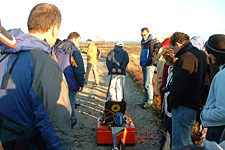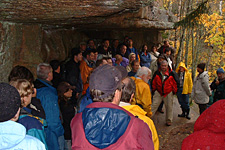1st International Conference, USA, 2004 – Conference Report

1st International Conference, USA, 2004 – Conference Report
IGCP Project 495
Conference Report

The inaugural meeting of the new IGCP sea-level change project was organised by Dan Belknap and Joe Kelly of the University of Maine, together with Duncan FitzGerald of Boston University and Ilya Buynevich of the Woods Hole Oceanographic Institute.
Bar Harbor was not an easy place to get to, but 55 conference delegates from twelve different countries found their way to this popular coastal resort town on the beautiful coast of central Maine, by various combinations of air, hire car, coach and taxi transportation.
As is always the case at these IGCP meetings, the mix of nationalities, friendly faces and the common interest ensured an enjoyable and inspiring atmosphere. The beautiful autumn colours made this a perfect time of the year to visit.
The meeting contained one and a half day of paper and poster presentations. The organisers started off with interesting talks on local sea-level related issues which provided the background for the fieldtrips of the following days.
A wide range of papers followed in the next day and a half, organised in four sessions:
- Quaternary variations in sea level and coastal responses
- Holocene sea-level changes and coastal process responses
- Human interactions with climate and coastal change
- Sea-level proxies and stratigraphic records
It is beyond the scope of this report to mention all the contributions, but some ‘highlights’ were provided by the novel and stimulating research of PhD students and young scientists who were present in considerable numbers. There was also a strong participation from scientists from Brazil, Kenya and Indonesia. In particular the following papers were noteworthy:
- The source of meltwater pulse 1A (Sophie Bassett, Durham, UK)
- Sea-level changes in Brazil (Rudolfo Angulo, Parana, Brazil)
- Sea-level changes in Newfoundland (Julia Daly, Maine, USA)
- Coastal remote sensing in Iran (Laetitia Dupin, Belgian Geological Survey)
- Sea-level changes in Iran (Vanessa Heyvaert, Belgian Geological Survey)
- Sea-level changes along the Great Barrier Reef (Sarah Woodroffe, Durham, UK)
- Coastal evolution in Kenya (Pamela Abuodha, Mombasa, Kenya)
- Late Holocene sea-level changes in Ulster (Mel Harman, Queen’s, Belfast, UK)
- Indus Delta evolution (Liviu Giosan, Woods Hole, USA)
- Late Holocene sea levels in the Mississippi Delta (Juan Gonzalez, Chicago, USA)
- Palaeomagnetic dating methods for sea-level reconstruction (Wil Marshall, Plymouth, UK)
- Indonesian sea levels and coral reefs (Wahyoe Hantoro, Bandung, Indonesia)
- Decompaction of coastal sediments (Matthew Brain, Durham, UK)
For a full listing of papers please contact the conference organiser Dan Belknap at [email protected] or visit the conference website at http://www.geology.um.maine.edu/IGCP/Index.html.
A key note address was delivered by Andrew Cooper (Ulster, UK) on coastal changes in South Africa and Ireland. After a splendid lobster dinner on the third night, we enjoyed a talk on the coastal archaeology of the Gulf of Maine by David Sanger of the University of Maine.

Traditionally, IGCP meetings contain an important field component and we spent some great days outside the conference rooms. There are few places in the world where sea-level change has left such a clear imprint on the landscape as on the coast of Maine. Evidence for sea-level change spans a total elevation range of 130 m, from +70 to -60 m, due to the dramatic (and still largely unexplained!) isostatic history of the area. We looked at evidence of high sea levels in the form of fossil sea stacks in Acadia National Park and glaciomarine ice-contact deltas along the classic Pineo Ridge. The latter feature had always been interpreted as a glacial moraine, but recent Ground Penetrating Radar records showed the beautiful topsets and prograding foresets in the stratigraphy of the ridge. Offshore lowstand deltas were discussed with the use of seismic records, while standing on beautiful Popham Beach. In a nearby salt marsh we collected a core to examine the sediments and we used the GPR to find evidence for recent storm events in the barrier stratigraphy. The most recent sea-level changes and coastal evolution were debated at Lubec Spit in eastern Maine, at Jasper Beach, one of the most beautiful gravel pocket beaches in all of New England, at Sand Beach in Acadia National Park, and in Rockland, where we examined a recent coastal landslide. Archaeology featured at the Damariscotta shell midden, the largest shell midden on the Atlantic coast of the Americas north of Brazil.
The conference organisers should be congratulated for organising such a stimulating IGCP meeting and pulling out all the stops for some great fieldtrips. This conference was an excellent way to start the new IGCP sea-level project. It was particularly good not only to see many familiar faces, but also to have so many UK postgraduate students attend this meeting, all presenting highly novel and exciting research. This is a good reflection of the IGCP spirit and it bodes well for the future of sea-level research in the UK.
For more information on IGCP Project 495, please contact the international project leader: Professor Antony Long ([email protected]).
Please drop me a note should you wish to receive mailings of the UK working group:
Roland Gehrels
School of Geography
University of Plymouth
Plymouth
PL4 8AA
[email protected]